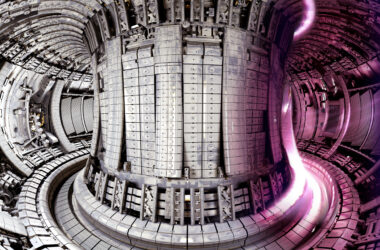A team of European Fusion Engineers have made a major breakthrough to create a working practical nuclear fusion reactor.
JET laboratory – a UK-based lab – has broken its existing record for how much energy can be extracted when squeezing together hydrogen atoms.
Watch our Born to Engineer film on Kim Cave-Ayland – she makes stars for a living
The idea behind Nuclear fusion is that you can slam two atoms slammed together in a reactor to form a heavier nucleus and unleash are larger amount of energy than your put in starting the reaction while practically producing no harmful emissions – this is the way the Sun and other stars produce energy.
Fusion is so promising that physicists have been trying to develop methods to safely harness this process for decades.
The JET laboratory experiment was able to produce 59 megajoules of energy over five seconds – that works out at 11 megawatts of power. During the last test in 1997 the lab only achieved half that output.
The achievement is significant as it supports the design choices that have been in another Fusion reactor – the ITER reactor. 10 years the JET was reconfigured to replicate the anticipated ITER set-up.
Speaking to the BBC Dr Joe Milnes, the head of operations at the reactor lab explained that “the JET experiments put us a step closer to fusion power [and] demonstrate that we can create a mini star inside of our machine and hold it there for five seconds and get high performance, which really takes us into a new realm.”
The Joint European Torus (JET) lab in Culham Oxfordshire and has been pioneering fusion over the last 40 years.








